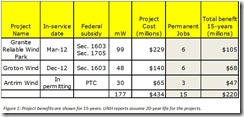Search Results for: "shale gas"
Relevance | DateWind Benefit Inflation: JEDI (NREL) Model Needs Reality Check
By Lisa Linowes -- December 12, 2012 3 CommentsSince 2009, the State of New Hampshire has reviewed three large-scale wind energy facilities, totaling 177 megawatts. In each case, the project proponents engaged University of New Hampshire Professor and economist Ross Gittell and his research assistant, Matt Magnusson, to conduct economic impact studies to show the long-term (20-year) benefits the projects would deliver to the local area.
Figure 1 summarizes the findings of each report (please click for better resolution).
The UNH researchers relied on NREL’s Jobs and Economic Development Impacts (JEDI) or similar linear spreadsheet models to assess job creation and economic impacts for the three projects: Granite Reliable Wind Park, Groton Wind and Antrim Wind. The methodologies and assumptions for the three studies appear nearly identical.
In all cases, their reports showed minor direct job opportunities (15 full-time equivalent positions for operations at the three sites) but substantially inflated indirect and induced job benefits relative to the local area.…
Continue Reading'Imagine' A New York World of Hydraulic Fracturing (and economical clean energy, sustainable jobs)
By Steve Everley -- November 15, 2012 7 CommentsIn recent months, the state of New York has been a focal point in the broader public debate over hydraulic fracturing. Activists in the state have teamed with musicians (in the loosest possible definition of the term) and Los Angeles movie stars to try to block shale development from occurring.
Hollywood’s finest, including Robert Redford and airline aficionado Alec Baldwin, as well as celebrities like meat-suit-wearing Lady Gaga have expended great effort in trying to undermine scientific conclusions about the safety of hydraulic fracturing.
Meanwhile, unemployment remains unacceptably high in the areas of upstate New York where prospective natural gas development would be located. So, it was with perhaps little surprise that when the voters in the Southern Tier had their say at the ballot box last week, they sent a clear message that they’ve had enough of “artists” telling them how to live their lives.…
Continue ReadingOrwellian Freedom: Green Party Platform (Part II)
By Robert Bradley Jr. -- November 7, 2012 4 Comments[Ed. note: Part I on Monday examined the Green Party’s Green New Deal; today’s post examines the rest of the Green Party’s platform with energy and the environment. With Obama’s reelection, it should not be forgotten that the philosophy and positions below–although not feasible for wholesale implementation–remain end-states for John Holdren and other Administration officials].
In George Orwell’s novel Nineteen Eighty-Four, published in 1949, the Ministry of Truth had three slogans: “WAR IS PEACE,” “FREEDOM IS SLAVERY,” and “IGNORANCE IS STRENGTH.” Enter the deep-ecology agenda, which is about controlling your resources and your life in the name of freedom for spaceship Earth.
Imagine Green Orwellian Freedom. Some of us would work in the public sector as green planners. More would work for government as enforcers, making sure the private sector is acting “sustainably.”…
Continue ReadingFractured Fairy Tales: Why Not Liberate Energy Technology for the 100%?
By Paul Driessen -- October 30, 2012 7 CommentsThe anti-industrial “green” movement, which once played nice with natural gas, is at war against hydraulic fracturing (fracing). Peak gas fears may be gone, and parasitic wind energy would crash without gas-fired generation to fill in, but an anti-energy agenda rules. What should be good news is parlayed into bad by the enemies of modernism.
Technology Jump–Societal Benefits
Horizontal drilling and hydraulic fracturing have boosted shale gas production from zero a few years ago to 10% of all U.S. energy supplies in 2012, observes energy analyst Daniel Yergin. Fracing has also increased U.S. oil production 25% since 2008 – almost all on state and private lands, and in the face of more federal land and resource withdrawals, permitting delays and declining public land production.
In the process, the fracing revolution created 1.7 million jobs in oil fields, equipment manufacturing, legal and information technology services, and other sectors.…
Continue Reading